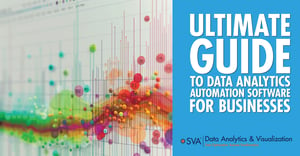





Discover the valuable insights our consultants provide. Subscribe to our Insights blog to receive email alerts whenever we post something new!


Published on: Jul 29, 2025 10:00:00 AM by Felix Krause
Updated on: July 29, 2025
Modern businesses run on massive streams of data, from transactions to customer interactions. As volumes grow, keeping that data clean and usable is critical. That’s where anomaly detection comes in. But is it a game-changer or just another analytics buzzword?
Let’s dig into what anomaly detection actually is, how businesses are using it, and why it’s something your company should prioritize.
At its core, anomaly detection is a technique for identifying patterns or behaviors in data that don’t fit the norm. Think of it as a digital version of “that doesn’t look right.”
It’s what’s behind the text you get from your bank asking, “Was this you?” after a suspicious transaction. But it goes far beyond fraud alerts.
There are a few different types of anomalies businesses encounter:
| Point Anomalies | These are single data points that stand out, like a vendor sending an invoice far higher than usual or a sale made at a suspiciously low margin. |
| Contextual Anomalies | These are out-of-place patterns within a particular setting or time frame. For example, a landscaping business getting a spike in sales in February might raise eyebrows, since that’s typically off-season. |
| Collective Anomalies | These involve groups of data points that, together, indicate something unusual, such as multiple login attempts from different locations within seconds, suggesting a potential security threat. |
 Insight: Creating Highly Consumable Quality Data with Data Integration
Insight: Creating Highly Consumable Quality Data with Data Integration
Anomaly detection tools can be as simple or advanced as your business requires. Many companies start with rule-based systems, where you set thresholds, flagging, for example, any bill from a vendor that exceeds $5,000.
The next step up includes statistical models, which analyze broader patterns using your data and return a score indicating whether something looks off. These models can account for nuance that static rules might miss, such as a high invoice that makes sense in the context of a seasonal project.
More advanced systems apply a mix of point and contextual analysis across your datasets. These tools can automatically detect unusual patterns and trigger alerts to help you respond quickly. In advanced systems, AI and machine learning are also used heavily.
Anomaly detection is gaining traction for good reason. It supports business operations in a variety of ways:
| Preventing Revenue Loss | From catching fraudulent charges to spotting missed billing errors, anomaly detection helps companies avoid financial leaks. |
| Maintaining Operational Efficiency | Delays in supply chains, performance issues in machinery, or unexpected system behaviors can all be caught faster, allowing for quicker responses. |
| Improving Customer Experience | Drops in engagement from a specific region or service outages can be flagged before customers even notice. |
| Supporting Real-Time Monitoring | With modern dashboards and alert systems, teams can be notified immediately when something unusual happens, no manual digging required. |
 Insight: Data Governance Best Practices: Ensuring Data Quality
Insight: Data Governance Best Practices: Ensuring Data Quality
It can be. When applied thoughtfully, anomaly detection gives businesses a faster way to catch problems, react, and adjust. As datasets and the amount of data available grows, anomaly detection easily develops into being a necessity for businesses.
Some of the biggest benefits include:
| Faster Decision-Making | Get real-time feedback when something’s off and act quickly. |
| Fewer Human Errors | Automated detection can catch mistakes that might otherwise slip by, like a vendor bill with an extra zero added. |
| Scalability | As your business grows, so does your data. Anomaly detection systems can grow with you, especially when powered by machine learning and AI. |
That said, it’s not always a perfect fit. While every business should be utilizing some form of anomaly detection, it doesn’t automatically solve every problem your business faces. The key is to incorporate it as part of a robust system, and not a standalone solution.
Anomaly detection works best when the data you feed it is clean, complete, and relevant. Otherwise, you're at risk of what’s often called “garbage in, garbage out.”
Other considerations:
| False Positives | Too many alerts can become noise, especially in the early stages. |
| Cost-Benefit Mismatch | Small businesses with limited data may not need advanced AI tools. Starting small with rule-based detection often makes more sense. |
| Overreliance on Alerts | Not every alert needs immediate action. It takes time to calibrate which signals matter most to your business. |
Ask yourself:
If you answered yes to any of these, anomaly detection might be worth exploring. But you don’t need to go from zero to full automation overnight. Start with simple rule-based alerts and expand from there if the data volume and business value support it.
 Insight: Ultimate Guide to Data Analytics Automation Software for Businesses
Insight: Ultimate Guide to Data Analytics Automation Software for Businesses
Anomaly detection isn’t just a trendy tech term. It’s a practical tool that can help businesses make better, faster decisions with their data.
The key is to approach it with clear goals and the right level of investment for where your business is today. When applied thoughtfully, it’s not just about catching what’s wrong, it’s about unlocking what’s possible.
© 2025 SVA ConsultingShare this post:

Felix is a Senior Business Solutions Consultant with SVA Consulting.







contact@svaconsulting.com

(800) 366-9091

1221 John Q Hammons Dr., Suite 201, Madison, WI 53717

18650 W. Corporate Dr., Suite 205, Brookfield, WI 53045

1600 Utica Ave S, 9th Floor,
Saint Louis Park, MN 55416

7135 E. Camelback Road, 230, Scottsdale, AZ 85251

109 West Commercial Street, Suite 107, Sanford, FL 32771
©2025 SVA Consulting, LLC. All Rights Reserved. | Privacy Policy | Cookie Policy | CCPA
